What a wonderful summer it has been for aquatic wildlife
Here’s a look back at life in the seas close to our shores with David Hall from Wild Roseland.
The sea has been full of fish, ranging from Cuttlefish and Pilchards to those exocet missiles of the sea – North Atlantic Tuna, and occasionally single Blue, Thresher and Porbeagle sharks.
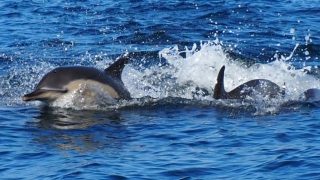
Not only that but cetaceans such as Common Dolphins, Risso’s Dolphins, and Porpoises have been here in exceptional numbers and, bewilderingly, both Minke whales and Fin Whales!
The Fin Whale is the second longest animal on the planet. An adult can grow to around 26 metres (85 ft) though the average length here is around 24.5 metres (80ft). Amazingly, double figures of Fin Whale were spotted, some close enough in to see with the naked eye, the sun reflecting on their surface-breaking backs and huge water vapour spouts erupting from their exhaling blowholes.
Together with other Cornwall Wildlife Trust “Seaquest Southwest” observers on the 20th of August we saw the first three on the Roseland off St Anthony’s Head. They stayed in the area for around three weeks. Even inshore fishermen were emotionally moved when these gentle giants came up alongside them. What a sight that must have been!
Why was all this happening?
Well, the other phenomenon was the huge number of unusual jellyfish, both in the sea and stranded on the shore. It’s all connected.
The sea temperature around the UK rose quite dramatically in April and May this year, warmer by up to 5 degrees Celsius in the North Sea than it had been since water surface temperature records began there in 1850.
This kind of temperature rise is classified by the US National Oceanic and Atmospheric Administration as a category 4 extreme marine oceanic heatwave. Scientific studies are showing that this is possibly due to a combination of factors. For example, human-induced global warming; the EL Nino phenomenon raising the sea temperature in the Pacific with world-wide consequences; sunlight intensity increasing as far less dust from the Sahara has filtered it recently; and weak ocean currents.
Whatever the reasons when sea surface temperatures change this has a disruptive effect on seawater species. They go “on the move” as the nutrients and oxygen levels change, causing harm to their established environment.
Here, the Plymouth Marine Laboratory established that the surface water from its Western Channel Observatory, just off the Eddystone lighthouse, was at its highest in June since records first began in 1961. For discussion of potential explanations please see below for details in their fascinating website.
The arrival of jelly fish
All in all, this created ideal conditions for plankton blooms to conglomerate, providing seafood for miniscule marine creatures, including Crystal Jellyfish, which are really hydrozoans, (Aequorea forskalia.) There are several kinds of Crystal Jellyfish, which usually can be identified by examining their DNA. See the work undertaken by Dr Paul Gainey and David Conway of the Marine Biological Association (MBA), also based in Plymouth. Details of the comprehensive MBA website are below. It’s well worth studying.
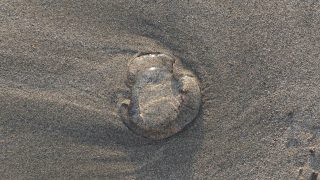
These Crystal Jellyfish, along with others,were deemed to be the ones which were stranded along Tatum’s beach in Portscatho, but which are more usually found in the Mediterranean or the USA western coast. They have a very rapid life cycle, producing thousands of larvae which mature extremely quickly. Another phenomenon, this time in Cadgwith Cove, just across the Fal Estuary on the Lizard was truly amazing.
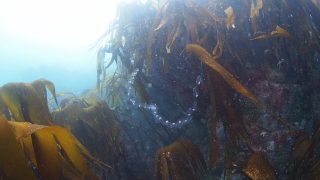
Strings of Salps looking like hallucinogenic miniature strings of Christmas fairy lights were filmed by snorkellers.
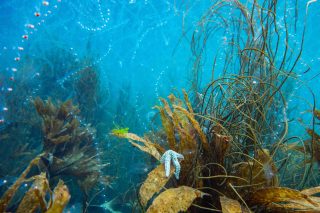
Others were photographed and filmed off Porthcurno, near the Minack by Heather Hamilton.
Her website Cornwall Underwater has some staggeringly beautiful shots of life beneath the surface of the sea.
The richness of the plankton may have been created by a pocket of warm ocean current in the Atlantic, generated by the force of the named storms in August ie Storms Antoni and Betty.
It all became a feeding frenzy while it lasted, bringing in the larger fish and the cetaceans in such unusual numbers, and, as the food diminished, our bay gradually returned to quieter times, although Atlantic Tuna and Portuguese Men O War are still around!
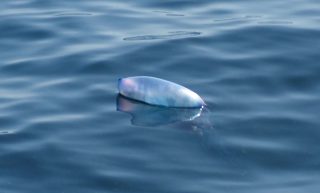
References/acknowledgements
Many thanks to Matt Slater: – Cornwall Wildlife Trust Marine Conservation Officer for his guidance on this article; and the Salp Chain photo off the Longships.
Plymouth Marine Laboratory website: – rsg.pml.ac.uk
Marine Biological Association website: – mba.ac.uk
Grateful thanks for permission to use the photos of Heather Hamilton, Cornwall Underwater: – Salps off Porthcurno .
The photos of the Common Dolphin feeding frenzy, stranded Crystal Jellyfish on Carne Beach, and Portuguese Man o’ War were taken by myself.
I hope this article goes some way towards explaining this summer’s marine phenomena; and that you have enjoyed reading it as much as I have enjoyed researching it, although I still have not been able to source a close-up of our visiting Fin Whales. Can anyone out there help?
David Hall
Wild Roseland

